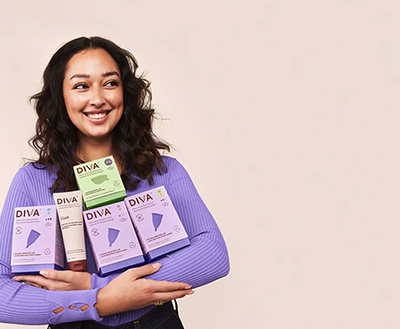

In your high school biology class, you may have learned about “normal” menstruation. That is, what constitutes a regular menstrual cycle according to textbooks. Even a simple Google search yields a lot of the same information of what a period should look like, but periods aren’t one-size-fits-all. What is normal to you may not represent the experience of someone else, and vice versa.
The Cleveland Clinic considers the following criteria to represent a regular menstrual cycle:
- Defined as monthly shedding of the lining of a woman’s uterus
- Lasts for 28 days on average but may last for 21 to 35 days
- Bleeding (aka menses) occurs for 3 to 5 days on average but can last for 2 to 7 days
- Symptoms can include cramps, bloating, acne, moodiness, food cravings, breast tenderness, and difficulty sleeping
Despite this standard definition of a menstrual cycle, there are a lot of factors that come into play. If your menstrual cycle doesn’t match the picture-perfect textbook definition, you may have abnormal menstruation. This is caused by a myriad of lifestyle behaviors or health conditions, such as stress, weight fluctuations, birth control pills, polycystic ovarian syndrome (PCOS), and much more.
A noteworthy cause of abnormal menstruation is endometriosis. Here’s how the condition can affect your menstrual cycle.
What is Endometriosis?
Endometriosis, often called “endo” for short, is an inflammatory disease that affects people with a female reproductive system who actively experience menstrual periods.
According to the National Library of Medicine, endometriosis is characterized by tissues that are similar to the lining of the uterus (called endometrium) and grow in other places of the body. The patches of tissues are referred to as nodules, implants, or lesions. They tend to grow on the ovaries, fallopian tubes, uterus, bowels, and bladder.

Symptoms of endometriosis can include:
- Abdominal pain
- Bleeding between periods (intermenstrual bleeding)
- Fatigue
- Gastrointestinal symptoms
- Heavy periods
- Infertility
- Pain during or after sex
- Painful bowel movements or urination
- Painful menstrual cramps
- Pelvic pain
As you can see, many of the symptoms of endometriosis involve intense pain or discomfort, and the symptoms can directly affect your period in several ways.
People who are at increased risk include those who have:
- A relative with endometriosis
- Short monthly cycles
- Heavy, long periods
- Never had children
- Certain health problems
It’s also more common in women in their 30s and 40s, though any girl or woman can develop this disease.
Endometriosis is usually a chronic disease that lasts for several years or for life. The exact cause is unknown, but the symptoms can be treated or managed. Researchers believe the most likely cause of endometriosis is retrograde flow, which is when period blood flows in the wrong direction. Genetic factors and elevated levels of the hormone estrogen are also potential contributors.
How Endometriosis Affects Your Cycle
Endometriosis affects the female reproductive system, so it’s directly related to a person’s menstrual cycle. Here’s how your period and fertility may be affected by endometriosis.
Heavy Flow
A person loses between 2 and 3 tablespoons of blood during their period, according to the Office on Women’s Health. This varies from person to person, and those with endometriosis are more likely to have a heavier menstrual flow and a period that lasts longer.
“Endometriosis can lead to heavier, more painful periods,” explains Jennifer Lincoln, MD, IBCLC, an OBGYN in Portland, Oregon. “This is because endometriosis is a condition where cells that are similar to those that line the uterus are found outside the uterus, so these hormone-responsive cells are going haywire in places they shouldn’t be, such as on the ovaries, fallopian tubes, bladder, intestines, and the outside surface of the uterus.”
This usually equates to having to change out your pads, tampons, or menstrual cups more frequently.
Pelvic Pain and Cramps
Pain is one of the most common symptoms of endometriosis. An estimated 75 percent of people with endometriosis experience pelvic pain, which tends to occur during your period.
You may feel pain near the pelvis or in the lower abdominal region. Menstrual cramps may also be more intense in those with endometriosis. Endometriosis pain can be debilitating.
Intermenstrual Bleeding
Spotting or bleeding between periods, known as intermenstrual bleeding, may occur in those with endometriosis. Heavy bleeding between periods can also occur, resembling a period.
Infertility
Having endometriosis is likely to increase the difficulty of getting pregnant. Infertility affects up to 50 percent of people with endometriosis.
One reason why endometriosis makes it harder to get pregnant is the formation of cysts called ovarian endometriomas or “chocolate cysts,” according to the Mayo Clinic. They form in the ovaries. This also increases the risk of ovarian cancer and pelvic pain.
This can also be explained by inflammation in the pelvis, altered hormone levels, reduced egg quality, scarred fallopian tubes, and impaired immune system function.
What You Can Do
While there is no cure for endometriosis, treatments exist for the main symptoms. Endometriosis pain can be treated with over-the-counter (OTC) or prescription pain relievers, hormone therapy like birth control pills, and surgery.
According to the Office on Women’s Health, regular exercise and keeping a low percentage of body fat can reduce your risk of developing endometriosis. However, it’s not preventable.
If you have endometriosis, you’re not alone. The disease affects an estimated 10 percent of people who menstruate globally.
















